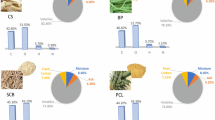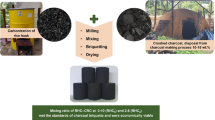Abstract
Corn stover (CS) and biosolids (BS), two easily accessible biomass (BM) resources, were combined in Co-pyrolysis (Co-Pyr) and Co-hydrothermal carbonization (Co-HTC) processes. The beneficial or catalytic effects of BS on CS in this process were identified by characterizing the following measured parameters of the produced char: ultimate and proximate analysis, higher heating value (HHV), van-Krevelen-diagram, activation energy (AE), and combustibility index S. The influence of the BS on CS was indicated by comparing the stated values of the CS/BS-mixed samples with the results of the pure BS- and CS-samples and the values of the unprocessed original BS and CS. The following developments were recognized: HHV of pure CS increased to 21–23 MJ/kg, that of pure BS was reduced to 7–9 MJ/kg, and for the mixed samples, one CS:BS-ratio showed beneficial interactions and resulted in 20–21 MJ/kg. The carbonization rate was advanced for the Pyr samples, ranging in the areas of coal and lignite, and most HTC samples in the area of peat and the original BM. The AE decreased from 65 and 41 kJ/g for the starting materials to an average of 30–40 kJ/g for most samples, and several samples reached 20–25 kJ/g. Hydrochars made from combined BM presented advanced combustibility index S values, passed 1 × 10–6, compared to Co-Pyr, and its biochar did not reach this combustibility index. CS and BS in pure and mixed forms, treated with Pyr or HTC, led to advanced solid fuels for different aspects of the analysis focus and depending on the composition of the sample.



© 2018 Itoh et al., 'van Krevelen diagram of raw manure and manure treated at 90 °C', used under CC BY / This figure is an excerpt of the original, replacing the original H/C- and O/C-sample-ratios)



Similar content being viewed by others
Data availability
All data generated or analyzed during this study are included in this published article (and its supplementary information files).
Code availability
Not applicable.
Abbreviations
- ash-wt:
-
Ash content in %
- A E :
-
Activation energy
- BC:
-
Biochar
- BM:
-
Biomass
- BS:
-
Biosolids
- CS:
-
Corn stover
- CY:
-
Char yield
- EY:
-
Energy yield
- FC:
-
Fixed carbon
- FTIR:
-
Fourier-transform infrared
- HHV:
-
Higher heating value
- HC:
-
Hydrochar
- SS:
-
Sewage sludge
- TGA:
-
Thermogravimetric analysis
- TL:
-
Trendline
References
Bai, F., Sun, Y.H., Liu, Y.M., Liu, B.C., Guo, M.Y., LÜ, X.S., Guo, W., Li, Q., Hou, C.B., Wang, Q.W.: Kinetic investigation on partially oxidized huadian oil shale by thermogravimetric analysis. Oil Shale 31(4), 377–393 (2014)
Channiwala, S., Parikh, P.: A unified correlation for estimating HHV of solid, liquid and gaseous fuels. Fuel 81, 1051–1063 (2002)
Deng, S., Tan, H., Wang, X., Yang, F., Cao, R., Wang, Z., Ruan, R.: Investigation on the fast co- pyrolysis of sewage sludge with biomass and the combustion reactivity of residual char. Bioresourc. Technol 239, 302–310 (2017)
Flynn, J.H., Wall, L.A.: A quick, direct method for the determination of activation energy from thermogravimetric data. J Polym. Sci. Part B Polym. Lett. 4(5), 323–328 (1966)
Gollakota, A.R.K., Kishore, N., Gu, S.: A review on hydrothermal liquefaction of biomass. Renew Sust. Energ. Rev. 81(1), 1378–1392 (2018)
Graham Solomons, T.W., Fryhle, C.B., Snyder, S.A.: Organic Chemistry, 12e Study Guide & Student Solutions Manual, 12th edn. John Wiley & Sons, Hoboken (2016). (ISBN: 111907732X)
He, X.L., Zhou, X.T., Sun, S.Q.: Feasibility analysis of application of Hefei City’s sewage sludge to soil. J. Hefei Univ. Technol. 31, 4 (2008)
He, C., Giannis, A., Wang, J.: Conversion of sewage sludge to clean solid fuel using hydrothermal carbonization: hydrochar fuel characteristics and combustion behavior. Appl Energ 111, 257–266 (2013)
Itoh, T., Iwabuchi, K., Ota, K.: A new approach to stabilize waste biomass for valorization using an oxidative process at 90 °C. PLoS ONE 13(4), e0196249 (2018)
Kang, S., Li, X., Fan, J., Chang, J.: Characterization of hydrochars produced by hydrothermal carbonization of lignin, cellulose, d-Xylose, and wood meal. Ind. Eng. Chem. Res. 51, 9023–9031 (2012)
Karampinis, E., Grammelis, P., Zethraeus, B., Andrijvskaja, J., Kask, Ü., Kask, L., Hoyne, S., Phelan, P., Casini, L., Picchi, G., Sandak, A., Sandak, J.: BISYPLAN: The Bioenergy System Planners Handbook. In: Proceedings of the 20th European Biomass Conference and Exhibition, pp. 2462–2464. Bisyplan, Milan (2012)
Lee, S., Choi, J.H.: Wastewater treatment transfer-operate-transfer (TOT) projects in China: the case of hefei wangxiaoying wastewater treatment TOT project. KSCE. J. Civ. Eng. 19(4), 831–840 (2014)
Long, J., Song, H., Jun, X., Sheng, S., Lun-shi, S., Kai, X., Yao, Y.: Release characteristics of alkali and alkaline eath metallic species during biomass pyrolysis and steam gasification process. Bioresour. Technol 116, 278–284 (2012)
Mohammed IY, Kazi FK, Yusuf SB, Alshareef I, Chi SA (2014) Higher heating values (HHV) prediction model from biomass proximate analysis data. In: ICCE 2014 Proceedings: October Quebec, Quebec, Canada,pp. 20–22,
Ozawa, T.: A new method of analyzing thermogravimetric data. Bull. Chem. Soc. Jpn. 38, 1881–1886 (1965)
Raheem, A., Sikarwar, V.S., He, J., Dastyar, W., Dionysiou, D.D., Wang, W., et al.: Opportunities and challenges in sustainable treatment and resource reuse of sewage sludge: a review. Chem. Eng. J. 337, 616–641 (2018)
Urych, B., Smolinski, A.: Kinetics of sewage sludge pyrolysis and air gasification of its chars. Energy Fuel 30, 4869–4878 (2016)
Yang, G., Zhang, G., Wang, H.: Current state of sludge production, management, treatment and disposal in China. Water Res. 78, 60–73 (2015)
Yu, L.J., Wang, S., Jiang, X.M., Wang, N., Zhang, C.Q.: Thermal analysis studies on combustion characteristics of seaweed. J. Therm. Anal. Calorim. 93(2), 611–617 (2008)
Zhai, Y., Peng, C., Xu, B., Wang, T., Li, C., Zeng, G., Zhu, Y.: Hydrothermal carbonisation of sewage sludge for char production with different waste biomass: effects of reaction temperature and energy recycling. Energy 127, 167–174 (2017)
Zhang, L., Wang, Q., Wang, B., Yang, G., Lucia, L.A., Chen, J.: Hydrothermal carbonization of corncob residues for hydrochar production. Energ. Fuel 29, 872–876 (2014)
Zhang, X.J., Zhang, L., Li, A.: Hydrothermal co-carbonization of sewage sludge and pinewood sawdust for nutrient-rich hydrochar production: synergistic effects and products characterization. J. Environ. Manage 201, 52–62 (2017)
Zhu, X.D., Liu, Y., Qian, F., Lei, Z., Zhang, Z., Zhang, S., Chen, J., Ren, Z.J.: Demethanation trend of hydrochar induced by organic solvent washing and its influence on hydrochar activation. Environ. Sci. Technol. 51(18), 10756–10764 (2017)
Acknowledgements
The authors are thankful to the Municipal Colleges and Universities Innovation Ability Promotion Projects of Beijing Municipal Education Commission (J2014QTXM0204), The International Science and Technology Cooperation Project of Anhui Province (1403062015), and The Science and Technology Project of Anhui Province (2013AKKG0398) for supporting this research. All figures were created using BioRender.com software.
Funding
This research was supported by the Municipal Colleges and Universities Innovation Ability Promotion Projects of Beijing Municipal Education Commission under Grant J2014QTXM0204; The International Science and Technology Cooperation Project of Anhui Province under Grant 1403062015; and The Science and Technology Project of Anhui Province under Grant 2013AKKG0398. The funding sources had no direct influence on the research but financial support.
Author information
Authors and Affiliations
Contributions
All authors contributed to the study's conception and design. Material preparation, data collection, and analysis were performed by SW, XJX, and XZ. The first draft of the manuscript was written by SW and all authors commented on previous versions of the manuscript. All authors read and approved the final manuscript.
Corresponding author
Ethics declarations
Conflicts of interest
The authors declare that they have no conflict of interest.
Additional information
Publisher's Note
Springer Nature remains neutral with regard to jurisdictional claims in published maps and institutional affiliations.
Rights and permissions
About this article
Cite this article
Weihrich, S., Xing, X. & Zhang, X. Co-pyrolysis and HTC refined biomass-biosolid-mixes: combustion performance and residues. Int J Energy Environ Eng 13, 657–669 (2022). https://doi.org/10.1007/s40095-021-00453-6
Received:
Accepted:
Published:
Issue Date:
DOI: https://doi.org/10.1007/s40095-021-00453-6




